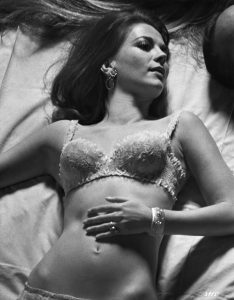When Bob & Carol & Ted & Alice debuted in theaters, it caused quite a stir with its daring exploration of relationships and shifting social values. Released in 1969, the film didn’t just entertain—it challenged norms, broke boundaries, and sparked conversations nationwide. Audiences were taken aback by its bold take on marriage, fidelity, and open relationships, themes that were rarely discussed so openly in mainstream cinema at the time. While the movie’s provocative content drew plenty of attention, few people realized that one of its stars, Natalie Wood, carried a personal secret that she carefully concealed throughout the film—a subtle choice that held deep meaning for her.

Natalie Wood, already a household name by the time she played Carol in the film, delivered a performance filled with grace, charm, and emotional authenticity. Her role helped anchor the story, allowing viewers to connect with the characters on a more personal level. However, Natalie’s presence in the movie marked more than just another acting credit—it was her first film in three years. Many saw it as a potential comeback, but after filming wrapped, Natalie took another extended break from Hollywood, not appearing in a major film again for nearly six years.
Behind the scenes, Bob & Carol & Ted & Alice was the brainchild of director Paul Mazursky, who drew inspiration from an article in Time magazine about Fritz Perls, a therapist known for unconventional methods. Mazursky and his wife visited the Esalen Institute in Big Sur, California, where Perls conducted therapy sessions in hot tubs surrounded by naked participants. Intrigued by the experience, Mazursky collaborated with writer Larry Tucker, and together they crafted a script that would become a defining piece of New Hollywood cinema—a movement that gave directors more creative freedom and tackled mature, often controversial, topics.
Mazursky’s journey into directing started with fear and uncertainty. On the first day of filming, he froze, overwhelmed by the pressure and responsibility of leading a movie set. It was Charles Lang, the director of photography, who saved the day by suggesting they ride a crane to find the perfect opening shot. Though terrified of heights, Mazursky agreed. Up in the air, Lang calmly talked him through the process, helping Mazursky regain his confidence. That pivotal moment turned him from a nervous newcomer into a self-assured director, a transformation he later joked about, calling himself a “cocky little bastard” from then on.
While audiences were captivated by the film’s themes and humor, very few noticed a constant detail about Natalie Wood—she always wore a bracelet on her left wrist. This wasn’t a fashion statement; it was a way to hide a wrist injury she’d suffered as a child while filming The Green Promise. During a scene, a bridge collapsed under her, leaving her with a disfigured wrist that never fully healed. Embarrassed by the deformity, Natalie made sure to wear a bracelet at all times, carefully positioning it so it remained visible, yet subtly hid the scar. This quiet act of self-consciousness speaks volumes about the private struggles that even the most glamorous stars endure behind the scenes.
Interestingly, Bob & Carol & Ted & Alice also marked the first on-screen appearance of Leif Garrett, who would later become a teen idol in the 1970s. At just five years old, Garrett had a small role in the movie, long before achieving fame as a singer and heartthrob. Additionally, if you look closely during the nightclub scene, you’ll spot a cameo by Bill Cosby, wearing sunglasses, a red shirt, and a hat, briefly bumping into Bob on the way to the table. Director Paul Mazursky also made a background appearance, screaming at the Esalen Institute, and the actor playing Alice’s therapist was none other than Mazursky’s own real-life therapist, Donald F. Muhich.
Natalie Wood’s fashion in the movie was nothing short of iconic. Designed by Moss Mabry, her wardrobe captured the free-spirited yet refined style of the late ’60s. Mabry even created a custom bra for Natalie, a piece that came to be known as the “Natalie Wood bra,” though the specifics of its design remained a well-kept secret. Whether dressed in bohemian attire or polished ensembles, Natalie effortlessly embodied elegance and approachability, further enhancing her on-screen presence.
Dyan Cannon, who played Alice, also experienced a career resurgence thanks to the film. After a difficult divorce from Cary Grant, marked by legal battles and financial strain, Dyan was determined to reclaim her career. She saw Bob & Carol & Ted & Alice as a lifeline and embraced her role with enthusiasm. In a 1968 interview, she revealed how, after months of feeling lost and overwhelmed, she finally found the strength to move forward and focus on her work. Her performance was well-received and marked a turning point in her personal and professional life.
Of course, no film is without its flaws, and keen-eyed viewers have spotted a few goofs in BCTA. In one restaurant scene, Alice and Ted begin eating their desserts, but in the very next shot, the desserts are just being served. Another moment shows Bob putting a record on the player, yet later, music plays even though the turntable is empty. And when Carol admits to an affair, Bob heads for the stairs wearing his coat, but in the following frame, the coat is off, and Carol is holding it. These minor slip-ups add a touch of charm and human error to an otherwise polished film.
One memorable scene—when the four main characters end up in bed together—was largely unscripted. Mazursky encouraged improvisation, wanting to capture genuine reactions and chemistry. While Robert Culp, playing Bob, handled the spontaneity with ease, the others were initially unsure, adding a layer of authenticity to the scene that critics praised.
Ultimately, Bob & Carol & Ted & Alice represented a major moment for its stars, especially Natalie Wood. While it opened a new chapter in her career, it was also the last major film she completed before her untimely death in 1981. The movie’s bold exploration of love and relationships mirrored the turbulent spirit of the 1960s, but Natalie’s real-life story was far more complex and tragic. Still, her performance stands as a testament to her talent, grace, and lasting impact on Hollywood. Sharing her legacy reminds us of the beauty, both seen and unseen, that she brought to the screen.





